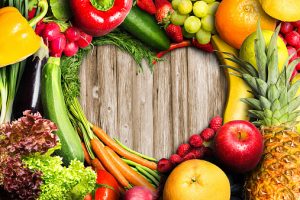
Most likely, when you were growing up, in school your teachers showed you a food pyramid. Each colored block indicated the recommended serving of each essential food group. Maybe in your earlier years you didn’t have many issues following these guidelines, but it’s probably been a while since you last saw this image.
Advertisement
Let’s give you a bit of a refresher…
| Recommended servings according to MyPyramid.gov for a 2000-calorie diet | |
|---|---|
| Grains | 6 oz. every day |
| Vegetables | 2 ½ cups every day |
| Fruits | 2 cups every day |
| Milk | 3 cups every day |
| Meat and beans | 5 ½ oz every day |
It doesn’t seem like a lot once you break it down, but new research has shown that when it comes to fruits and vegetables, Americans aren’t having enough.
1 in 10 Americans eat recommended serving of fruits and vegetables
 According to the Centers for Disease Control and Prevention (CDC) only one in 10 Americans eat the recommended amount of fruits and vegetables. To be more specific 13 percent of the American population consumes the serving amount for fruits daily and less than nine percent reaches the recommended amount of vegetables.
According to the Centers for Disease Control and Prevention (CDC) only one in 10 Americans eat the recommended amount of fruits and vegetables. To be more specific 13 percent of the American population consumes the serving amount for fruits daily and less than nine percent reaches the recommended amount of vegetables.
The CDC’s report notes even though residents of California have the highest amount of people who eat healthy, they too fall behind with only 13 and 18 percent of their population eating the recommended fruit and vegetable servings.
In the lowest group, come residents from Tennessee and Mississippi.
Authors of the new report from the CDC suggest bigger efforts to promote eating fruits and vegetables. Fruits and vegetables offer essential nutrients, which are important for overall good health. Let’s explore some benefits that this food group can provide.
Benefits of fruits and vegetables
 The consumption of fruits and vegetables has been shown to reduce the risk of many illnesses including cardiovascular disease and diabetes. Fruits and vegetables are commonly low in fat with no cholesterol, which not only helps with weight maintenance but keeps arteries clear as well.
The consumption of fruits and vegetables has been shown to reduce the risk of many illnesses including cardiovascular disease and diabetes. Fruits and vegetables are commonly low in fat with no cholesterol, which not only helps with weight maintenance but keeps arteries clear as well.
As mentioned, fruits and vegetables provide nutrients. These nutrients are used by the body to help maintain proper bodily functions. Fruits and vegetables can boost cardiovascular and digestive health.
Here is a list of specific benefits that can be obtained from fruits and vegetables:
- Vision health
- Healthy blood pressure
- Prevents constipation and diarrhea
- Help form red blood cells
- Reduces and maintains healthy cholesterol
- Keeps skin healthy
- Reduces risk of heart attack and stroke
- Maintains oral health
- Combats free radicals
- Provides energy.
Really, fruits and vegetables are the key for good health and the fact many Americans aren’t getting the recommended servings can be a reason for many chronic health conditions. It is then important that we begin to incorporate more of this food group into our diet. Additionally, it’s important to relay the importance of this message to future generations as a means of preventing illness and setting them up to practice healthy habits.
How to consume more fruits and vegetables
 Maybe you don’t like broccoli, or red peppers just don’t do it for you. You won’t eat things you won’t enjoy, so the secret is finding the food items you like and learning how to prepare them in a variety of ways.
Maybe you don’t like broccoli, or red peppers just don’t do it for you. You won’t eat things you won’t enjoy, so the secret is finding the food items you like and learning how to prepare them in a variety of ways.
Besides finding fruits and vegetables you like to eat, here are some other tricks and tips you can try:
- Create smoothies to mask the taste of certain fruits or vegetables
- Keep fruits and vegetables readily available in your fridge
- Try frozen options to save time and money
- Eat majority in the morning
- Consume vegetables before protein
- Add vegetables into your main meals.
These are some alternative ways you can begin to enjoy more fruits and vegetables in your diet along with their many health benefits.
Fruits and vegetables are important to eat daily as they can help ward of many illnesses. Don’t deny yourself their benefits – find easy ways to enjoy more and you’re health will improve.
Related Reading:
How fruits can help you burn calories
Fat comes in a few different forms: White, brown and beige. White fat is the stubborn kind that likes to hang around where you don’t want it. Brown fat works to burn energy and produce fat. Beige fat, on the other hand, is the useful fat which aims to convert white fat into brown fat so it can be burned off. So if we can promote more beige fat in our body we can burn more calories and have greater weight loss. Continue reading…
Advertisement
Get more out of your vegetables with this one easy addition…
Even though the basic premise of a salad involves a leafy green and then additional toppings, there is one topping that can boost your absorption of all of those essential nutrients, so much so the absorption is increased 500 percent! Skeptical? Don’t be, because that extra ingredient is a superfood in its own right already. Continue reading…
Sources:
http://www.livescience.com/35730-five-easy-ways-eat-more-fruits-vegetables.html
http://www.choosemyplate.gov/food-groups/vegetables-why.html
http://www.cnpp.usda.gov/sites/default/files/archived_projects/FGPPamphlet.pdf
http://www.medicalnewstoday.com/articles/296677.php
http://www.everydayhealth.com/news/only-1-10-americans-eats-enough-fruits-veggies-cdc/?xid=tw_everydayhealth_sf
